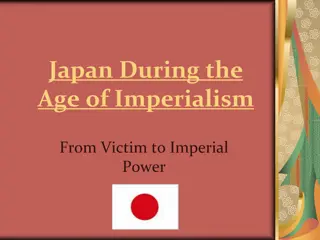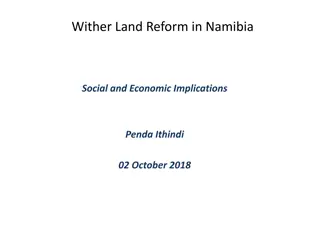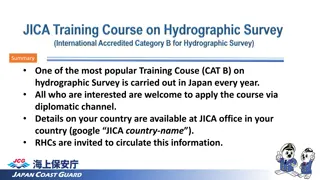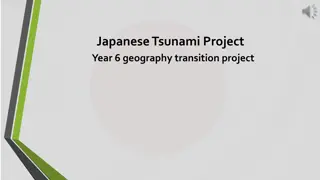Discovering Japan: Land of the Rising Sun and Rich Traditions
Japan, an archipelago in East Asia, boasts a unique geography with mountainous terrain and limited farmland, leading to innovative farming techniques. Surrounded by seas, Japan's isolation protected it while facilitating trade. Early Japanese traditions emphasize clan divisions, the Yamato dynasty, and the Shinto religion's reverence for nature.
Download Presentation

Please find below an Image/Link to download the presentation.
The content on the website is provided AS IS for your information and personal use only. It may not be sold, licensed, or shared on other websites without obtaining consent from the author. Download presentation by click this link. If you encounter any issues during the download, it is possible that the publisher has removed the file from their server.
E N D
Presentation Transcript
JAPAN LAND OF THE RISING SUN
JAPAN ARCHIPELAGO chain of islands 100 miles east of the Asian mainland Four main islands Hokkaido, Honshu, Shikoku and Kyushu plus 3,000 smaller ones About the size of Montana Climate similar to eastern United States
JAPAN Only 20% of the land is suitable for farming Very mountainous Most people settled in narrow river valleys and along coastal plains Used terracing to farm sides of mountains Japanese also turned to the sea for food (protein)
Japan Seas also protect Japan seas kept Japan mostly isolated from the Asian mainland Japan close enough to Korea and China for trade Far enough away not to be conquered Seas served as trade routes Japan located the Ring of Fire earthquakes and volcanic eruptions Cause tsunami
Early Japanese Traditions Early Japanese society divided into clans- family groups that trace their origins to a common ancestor Yamato clan will gain control around 500 CE Yamato set up Japan s first and only dynasty Claimed descent from the Sun Goddess, Amaterasu and the rising sun became the Yamato symbol
Early Japanese Traditions Traditional religion of Japan is Shinto means way of the gods based on the worship and respect for nature no sacred text Created out of the worship of Kami word means spirits natural forces found in all things Shrines built to honor nature usually around waterfalls, mountains, grove of ancient trees
Early Japanese Traditions Japanese language similar to Korean but totally different from Chinese Korea and Japan in constant contact migrations and warfare a constant in early centuries CE Buddhist missionaries from Korea introduced religion to Japan around 500 CE
Chinese Influence Prince Shotoku will be very influential in spreading Chinese culture and Buddhism Sent missions to Tang China to gather knowledge of Chinese ways Many more missions will follow over next 200 years Returned and spread Chinese art, technology, thought and ideas on government
Chinese Influence Japanese emperor built new capital at Nara modeled on the Chinese capital Nobles spoke Chinese dressed Chinese ate Chinese foods Tea drinking and tea ceremony introduced Chinese became official writing system of officials and scholars Chinese influence only reached small group
In architecture the Japanese adopted the pagoda style Buddhist monasteries were built very powerful Confucian ideas took root in Japanese society
Chinese Influence Japanese will later begin selective borrowing Will never adopt Chinese civil service exam Relied upon inheritance to fill government positions educated sons of nobles Japan produced its own unique civilization Added kana (phonetic symbols representing syllables) to Chinese writing
Heian Period 794 to 1185 Heian period saw Chinese influence reach it s peak and then decline Capital located in Heian (present-day Kyoto) Fujiwara family in control of the throne Small population of nobles controlled society Emperors were figureheads (religious ceremonies) Feudalism introduced during this period
Heian Capital http://upload.wikimedia.org/wikipedia/commons/thumb/0/07/Daidairi_of_Heiankyo.jpg/250px-Daidairi_of_Heiankyo.jpg
Heian Period Court etiquette governed society beauty important (what made one a good person) Noblewomen/men blackened their teeth and powdered their faces men faint moustache and thin goatee Noblewomen wore hair to ankles, dyed clothing to match seasons (12 layered silk robe), eyebrows plucked or shaved and redrawn higher up on forehead Everyone in court expected to write poetry/paint
http://upload.wikimedia.org/wikipedia/commons/thumb/5/53/Junihitoe.jpg/220px-Junihitoe.jpghttp://upload.wikimedia.org/wikipedia/commons/thumb/5/53/Junihitoe.jpg/220px-Junihitoe.jpg http://upload.wikimedia.org/wikipedia/commons/thumb/9/93/Ch5_wakamurasaki2.jpg/220px-Ch5_wakamurasaki2.jpg
Heian Literature Women produced the most important literature of the period (women were forbidden to learn Chinese) wrote in kana Sei Shonagon wrote The Pillow Book Lady Murasaki the best known writer of the period wrote The Tale of Genji (1010) which is considered by many to be the world s first novel
Zen Buddhism New Buddhist sect will win widespread acceptance called Zen Zen means meditation and stresses devotion to duty Values peace, simplicity, love of beauty and reverence to nature Did not conflict with Shinto Landscape gardening and painting
Artistic Traditions Two types of drama will become popular No (Noh) drama performed on wooden stage without scenery men wore mask (1300s) Kabuki drama included comedy and melodrama (1600s) violence and emotion portrayed family and historical events popular with townspeople In poetry Japanese created the haiku miniature poem (3 lines 17 syllables in Japanese language) Woodblock printing art form (1600s)
Japanese Feudalism Feudal system developed in Japan during the Heian period Warrior aristocracy dominated Japanese society Warlords had men under their command loyal to them not to the central government In theory the emperor was at the head of the country but actually he was powerless
Feudal Japan Power in the hands of the Shogun or supreme military commander Gave land to vassals great warrior lords called Daimyo Lesser warriors called samurai those who serve fighting force in feudal Japan Ronin were samurai who had lost their master
Feudal Japan Samurai followed the code of Bushido which means way of the warrior Loyalty to lord put above all other things Betray their code then they were expected to commit seppuku, ritual suicide Dying an honorable death better than living a long life that was dishonorable
Kamakura Shogunate 1100s two powerful clans Taira and Minamoto fought for control lasted 30 years Minamoto emerged victorious and in 1192 Yoritomo Minamoto took title of shogun Emperor still ruled in Kyoto but real power with shogun
Kamakura Shogunate Mongols launched two unsuccessful naval invasions of Japan during this period Mongol ruler was Kublai Khan (grandson of Genghis Khan) who sent fleets in 1274 and 1281 Japan saved both times by typhoons which the Japanese called kamikaze or divine wind
Civil War Period Period between 1467 and 1568 known as the Sengoku or warring states period Powerful daimyo controlled this period warring amongst themselves for control Saw the arrival of the first Europeans to Japan, the Portuguese brought their religion as well Oda Nobunaga will eventually defeat all rivals used firearms for the first time effectively in Japan during a battle
Civil War Period Nobunaga will never unite all of Japan Toyotomi Hideyoshi will succeed Nobunaga and will control most of country by 1590 Failed expeditions against Korea kept him from uniting all of Japan
Tokugawa Shogunate The unification of Japan will be completed by Tokugawa Ieyasu Defeated his rivals at the battle of Sekigahara in 1600 In 1603 he took the title of Shogun Moved the capital to Edo (present-day) Tokyo
Tokugawa Shogunate Required daimyo to spend every other year in the capital Family had to stay at Edo at all times Ieyasu will ban Christianity Kicked all Westerners out of Japan with the exception of the Dutch Dutch allowed to come to Nagasaki to trade once a year
Tokugawa Shogunate Shoguns able to control daimyo by setting up a strong central government Brought peace and prosperity Orderly society because they put restrictions on social classes























